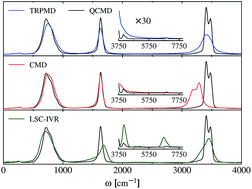当前位置:
X-MOL 学术
›
Faraday Discuss.
›
论文详情
Our official English website, www.x-mol.net, welcomes your feedback! (Note: you will need to create a separate account there.)
Which quantum statistics-classical dynamics method is best for water?
Faraday Discussions ( IF 3.4 ) Pub Date : 2019-12-16 , DOI: 10.1039/c9fd00077a Raz L Benson 1 , George Trenins , Stuart C Althorpe
Faraday Discussions ( IF 3.4 ) Pub Date : 2019-12-16 , DOI: 10.1039/c9fd00077a Raz L Benson 1 , George Trenins , Stuart C Althorpe
Affiliation

|
There are a variety of methods for including nuclear quantum effects in dynamics simulations by combining quantum Boltzmann statistics with classical dynamics. Among them are thermostatted ring-polymer molecular dynamics (TRPMD), centroid molecular dynamics (CMD), quasi-centroid molecular dynamics (QCMD), and the linearised semi-classical initial value representation (LSC-IVR). Here we make a systematic comparison of these methods by calculating the infrared spectrum of water in the gas phase, and in the liquid and ice phases (using the q-TIP4P/F model potential). Some of these results are taken from previous work, and some of them are new (including the LSC-IVR calculations for ice, and extensions of all the spectra into the near-infrared region dominated by overtone and combination bands). Our results suggest that QCMD is the best method for reproducing fundamental transitions in the spectrum, and that LSC-IVR gives the best overall description of the spectrum (albeit with large errors in the bend fundamental band caused by zero-point-energy leakage). The TRPMD method gives damped spectra that line up with the QCMD spectra, and is by far the cheapest method.
中文翻译:

哪种量子统计-经典动力学方法最适合水?
通过将量子玻尔兹曼统计量与经典动力学相结合,可以采用多种方法将核量子效应包括在动力学模拟中。其中包括恒温环聚合物分子动力学(TRPMD),质心分子动力学(CMD),准质心分子动力学(QCMD)和线性化的半经典初始值表示(LSC-IVR)。在这里,我们通过计算气相,液相和冰相中水的红外光谱(使用q-TIP4P / F模型电势)来对这些方法进行系统的比较。这些结果中的一些取自先前的工作,而另一些则是新的(包括LSC-IVR的冰计算,以及将所有光谱扩展到以泛音和组合谱带为主的近红外区域)。我们的结果表明,QCMD是再现频谱中基本跃迁的最佳方法,而LSC-IVR提供了频谱的最佳整体描述(尽管由于零点能量泄漏而导致的弯曲基带误差较大)。TRPMD方法产生的阻尼光谱与QCMD光谱一致,是迄今为止最便宜的方法。
更新日期:2019-12-17
中文翻译:

哪种量子统计-经典动力学方法最适合水?
通过将量子玻尔兹曼统计量与经典动力学相结合,可以采用多种方法将核量子效应包括在动力学模拟中。其中包括恒温环聚合物分子动力学(TRPMD),质心分子动力学(CMD),准质心分子动力学(QCMD)和线性化的半经典初始值表示(LSC-IVR)。在这里,我们通过计算气相,液相和冰相中水的红外光谱(使用q-TIP4P / F模型电势)来对这些方法进行系统的比较。这些结果中的一些取自先前的工作,而另一些则是新的(包括LSC-IVR的冰计算,以及将所有光谱扩展到以泛音和组合谱带为主的近红外区域)。我们的结果表明,QCMD是再现频谱中基本跃迁的最佳方法,而LSC-IVR提供了频谱的最佳整体描述(尽管由于零点能量泄漏而导致的弯曲基带误差较大)。TRPMD方法产生的阻尼光谱与QCMD光谱一致,是迄今为止最便宜的方法。



























 京公网安备 11010802027423号
京公网安备 11010802027423号